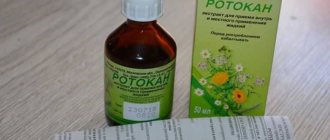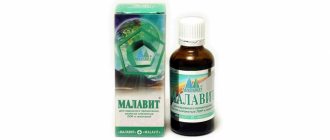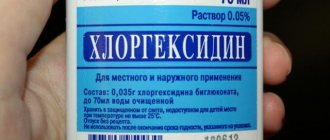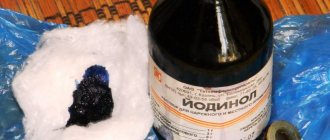Chlorhexidine is a solution antiseptic that should always be in your home medicine cabinet. Chlorhexidine helps well with burns. It destroys most of the known pathogenic bacteria that provoke purulent inflammation of burnt skin. It has been used in medical practice for more than 60 years to disinfect burn wounds and prevent bacterial complications. The antiseptic is used for both emergency and further treatment of burns. They disinfect the skin, mucous membranes of the mouth, nasal cavity and other areas.
Is it possible to treat a burn with Chlorhexidine?
When using Chlorhexidine for burns, you should pay attention to the concentration of the active ingredient in it - chlorhexidine bigluconate. For local and external use, 0.05%, 0.2% and 0.5% antiseptics are suitable. More concentrated products are intended for disinfection of medical instruments or undamaged skin.
This effective antiseptic destroys up to 80% of pathogenic fungi and bacteria. It is used in the form:
- applications;
- rinsing;
- irrigation;
- rinsing.
The drug prevents wound infection and purulent inflammation of wound surfaces.
What effect does Chlorhexidine have on a burn wound?
Chlorhexidine bigluconate interacts with protein components inside microbial cells. Penetrating intracellular membranes, it prevents bacteria from breathing. Because of this, the ATP content decreases, the osmotic balance is disrupted, which leads to cell death. The antiseptic destroys the DNA of pathogenic fungi and bacteria and prevents their reproduction.
Dermatologists advise using Chlorhexidine for burns to eliminate bacteria and fungi on the surface of the wound:
- gonococci;
- bacteroids;
- treponema pallidum;
- microbial spores;
- yeast-like fungi;
- chlamydia, etc.
The medicine retains bactericidal activity in the presence of purulent fluid and blood in the wound, prevents tissue infection, purulent complications - regional lymphadenitis, phlegmon, abscesses. Shows antimicrobial effect within 5-6 hours after application.
The burn should be treated with Chlorhexidine in the form of an aqueous solution. Buy a ready-made pharmaceutical 20% preparation and dilute it correctly with water.
Acid-fast fungi and bacteria, as well as the herpes virus, are insensitive to the medicine. The drug is used in anti-burn therapy to achieve the following effects:
- cleansing the burn from pathogenic flora;
- elimination of redness and swelling;
- reduction of local temperature;
- prevention of bacterial inflammation;
- acceleration of skin regeneration.
Unlike many other drugs, Chlorhexidine does not cause burning or irritation of the mucous membranes and skin. It does not affect the healing rate of burn wounds and has a minor list of contraindications.
Water-based chlorhexidine is used to treat burns. It is available in different dosage forms:
- The gel is a bactericidal medicine with an anti-inflammatory effect. Intended for external use for minor burns. Its components do not irritate mucous membranes and do not stain tooth enamel. Therefore, the gel is used to disinfect wounds inside the oral cavity.
- A 0.05% solution is a mild antiseptic that is used to treat burns in the groin area. It does not irritate the mucous membranes of the genitals and, if necessary, is injected into the urethral canal.
- 0.2% solution is a mild disinfectant. Used to irrigate the nasopharynx and rinse the mouth. Accelerates scarring of mucous membranes, prevents the proliferation of bacteria in the wound.
It is strictly not recommended to use a 0.5% alcohol-based antiseptic to disinfect burns. The concentrated preparation is suitable for disinfecting hands only if the skin is intact.
If you are hypersensitive to the components of Chlorhexidine, allergic reactions are possible - itching, burning, dryness, skin rashes.
How to use correctly
To treat the skin and mucous membranes of burn injuries, only an aqueous solution of Chlorhexidine is used. It is used in two ways:
- Irrigation - washing burns to disinfect damaged areas of the body. After disinfection, the injured skin is treated with anti-burn ointments - Rescuer, Pantoderm, Dermazin, etc.
- Applications - applying a dressing soaked in the preparation to the burned areas. Compresses are used for suppuration and oozing. Application time should not exceed 2-3 minutes. The procedure is performed three times a day until healing.
Chlorhexidine is intended for the treatment of relatively shallow 1st and 2nd degree burns complicated by bacterial inflammation. To prevent deepening of the wound, it is used in diluted form. For the treatment of damaged mucous membranes and skin, 0.05%, 0.02% or 0.5% solutions are prescribed.
To prevent purulent inflammation, a weakly concentrated drug is used. If there is a high risk of wound infection, 0.05% Chlorhexidine is used. The concentrated antiseptic has a pronounced bactericidal effect, so it is used to destroy pathogenic flora during suppuration.
To prepare a disinfectant with the required concentration of the active substance, the pharmaceutical preparation is diluted. Distilled or boiled water is used as a solvent. The medicine is prepared immediately before treating burns and is not reused after 3-6 hours.
Features of the preparation of weakly concentrated solutions from 20% Chlorhexidine:
- 0.5% solution - intended to destroy infection during purulent complications. For 25 ml of the drug there are 975 ml of distilled water.
- 0.05% solution – destroys pathogenic flora during bacterial inflammation of burned skin. To prepare the drug, mix 2.5 ml of Chlorhexidine with 997 ml of water.
- 0.02% solution is a medicine with a bacteriostatic effect, which is used to prevent bacterial inflammation. There are 999 ml of water per 1 ml of concentrated solution.
The concentration of the solution is chosen based on the severity of the damage - the shallower the depth of the wound, the lower the content of chlorhexidine digluconate should be. For 1st degree injuries without compromising the integrity of the skin, the least concentrated product is used.
The prepared medicine is treated with burnt skin. To do this, cotton wool is generously moistened in the solution and carefully applied to the injured areas. The procedure is performed 2-3 times a day before applying anti-inflammatory or wound-healing ointments.
For suppuration, compresses with a concentrated solution are used. Cotton pads are moistened with antiseptic and applied to the wound for 2-3 minutes up to 3-4 times a day. To increase the effectiveness of treatment, the drug is prepared immediately before use.
Superficial burns on the skin are treated with gel. It is applied openly or under a bandage three times a day. Therapy is continued for 3-4 days. When blisters form on the body, it is recommended to combine the disinfectant with other drugs - Solcoseryl, Eplan, Argosulfan.
Urethral lavage during self-medication
Washing the urethra at home is possible no further than its anterior segment. Therefore, doing instillations for medicinal purposes on your own is not only pointless, but also dangerous. No amount of rinsing the urethra with potassium permanganate or even miramistin can cope with the inflammatory process in the posterior parts of the canal. No matter how proven the solution may be, washing the urethra on your own is unlikely to be able to push it beyond the first six to seven centimeters. This means that the posterior segment of the urethra will be infected. And then bacterial, viral, protozoal agents can easily begin to travel through the genitals and blood, causing prostatitis, vesiculitis, orchiepididymitis or visceral lesions. It is also worth remembering that the same chlorhexidine or miramistin are absolutely indifferent to such STI pathogens as chlamydia. The latter are quite resistant to instillations and can tolerate unfavorable conditions, forming foci of chronic infection. It makes no sense to try to independently administer potassium permanganate or furatsilin in order to treat urethritis. This only creates the illusion of activity in the patient, threatening to transfer him to the category of traumatic patients with burns or canal injuries.
Adverse reactions
A concentrated antiseptic solution provokes allergic reactions. Incorrect dosage calculation and abuse of a disinfectant leads to the following consequences:
- redness;
- dryness;
- skin stickiness;
- salivation;
- taste disturbances;
- skin rashes;
- contact dermatitis.
In 96% of cases, adverse reactions disappear after discontinuation of the drug.
Do not use a 20% antiseptic to disinfect open wounds. This is fraught with a chemical burn and worsening the condition of the burned skin.
Accidental ingestion of the medicine leads to poisoning and diarrhea.
In what cases is the use of antiseptics prohibited?
Chlorhexidine is not used in case of hypersensitivity to the active or auxiliary components. Contraindications to its use are:
- exacerbation of dermatitis;
- tendency to allergies;
- parallel intake of iodine preparations;
- 3rd and 4th degree burns;
- relapses of herpes zoster.
Use the medicine with caution to treat burns in patients under 16 years of age. Children's skin is prone to allergic reactions, so treating wound surfaces with 0.5% antiseptic is fraught with nettle fever.
Is it painful to wash the urethra?
An experienced urologist performs such procedures not only correctly, but quickly and painlessly. After all, he has skills in his hands that have been developed over the years. The instillation regimen must be chosen correctly, and the patient is not allergic to the selected solution. A slight burning sensation after washing the urethra, caused more by damage to the mucous membrane by the main inflammatory process, is all that he can feel. This is a clear advantage of a catheter in the hands of a professional. Even after using all the tools and materials, a person without experience can not only scratch, but even more roughly violate the integrity of the urethra. Causing not only pain, but also bleeding. It is better for the patient to urinate before the procedure. After all, after administering the medicine, it is recommended to delay urination for half an hour to an hour. Before inserting the catheter, the doctor treats the head and external opening of the urethra with an antiseptic. After this, a sterile catheter is inserted into the urethra. Its free end is attached to a disposable syringe containing medication, which is slowly injected into the urethra. Next, the catheter is removed. No pain relief is required during or after the procedure. It should be remembered that you should immediately report any painful reactions or allergic manifestations during procedures or medications to your doctor. Also, you should not conceal episodes of allergies or other drug intolerances that have been noted previously. This will allow the patient to achieve maximum safety, and the doctor to choose the most gentle and correct treatment regimen. If discomfort or allergies appear after independent home manipulations, it makes sense to immediately seek advice from a urologist. The same recommendations apply to canal injuries. Thus, if you need to wash the urethra for therapeutic purposes, it is advisable to contact a venereologist or urologist. It is better to do this in a clinic equipped with a laboratory, so as not to delay either competent diagnosis or effective treatment.
Can Chlorhexidine burn your skin?
Chlorhexidine burns occur when wounds are disinfected with concentrated solutions. Even healthy skin cannot be treated with a 20% antiseptic, as it provokes chemical injuries. The burning effect of the drug is enhanced by alcohol-based medications. Therefore, in anti-burn therapy, only an aqueous solution is used. If a burn occurs with this drug, the skin should be rinsed under running cold water for 15-20 minutes.
Chlorhexidine is an effective disinfectant that does not interfere with the restoration of the skin or mucous membranes. It is considered a first-line drug in the treatment of burn injuries. Thanks to its bactericidal properties, it is effective against bacterial and purulent complications.
Consequences of self-washing the urethra
Complications of washing the urethra at home on your own can be very diverse:
- burns of the mucous membrane up to the formation of strictures (narrowings) of the urethra, complicating urination;
- the spread of infectious agents up to the generalization of the infection; the formation of carriers of the infection;
- erectile dysfunction;
- infertility;
- urethral injuries and bleeding from it.
The consequences of a thoughtless attitude to the use of medications are subsequently much more expensive than high-quality treatment from a competent specialist.











